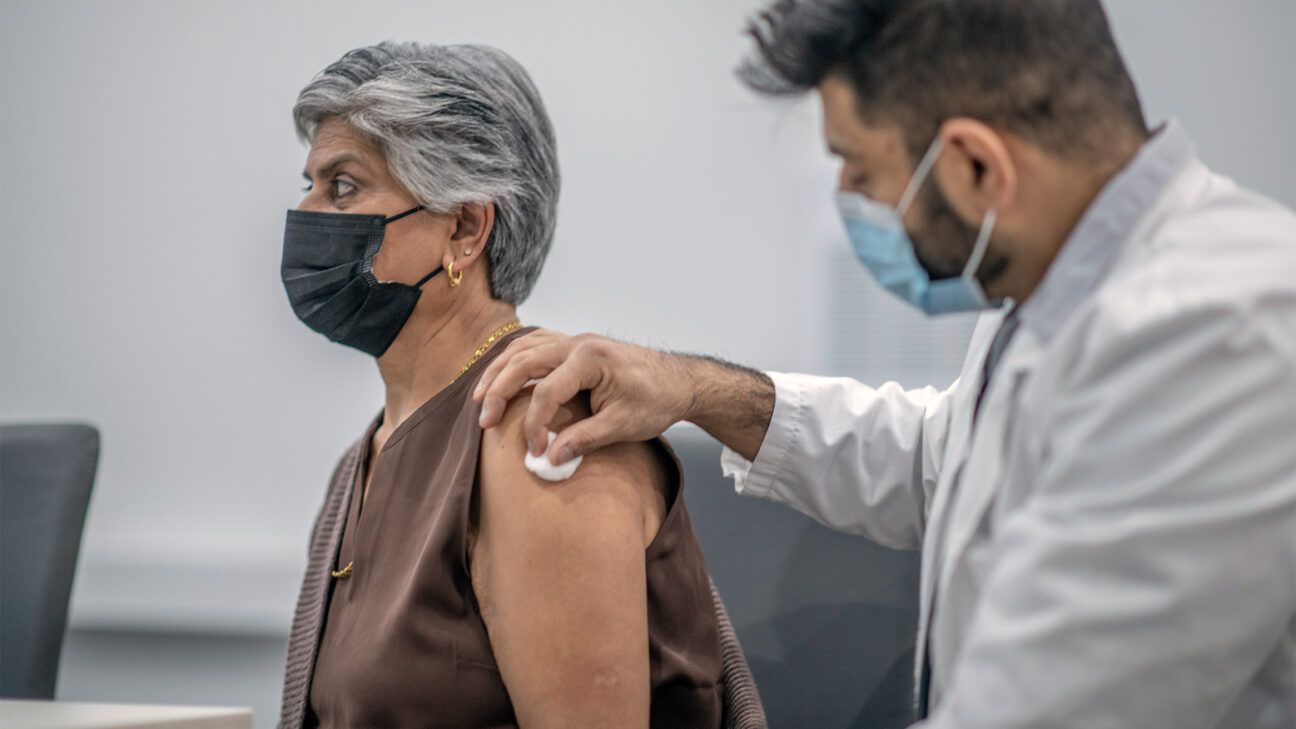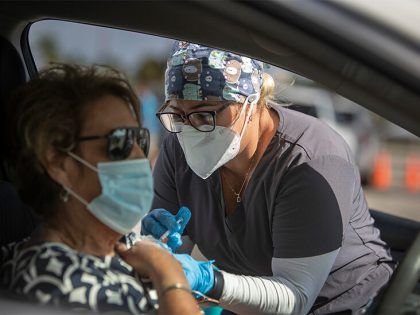Health News
Why the New COVID-19 Booster Was Authorized Before Testing on People

- The new COVID-19 boosters were authorized before being tested on humans, but experts say that they are still safe.
- The FDA said in a statement that it based its decision on the "totality of available evidence."
- With the COVID-19 vaccines, there is already a long track record of safety to support the new boosters.
The Food and Drug Administration authorized new bivalent COVID-19 boosters on Aug. 31 that target both the original form of the coronavirus and the currently circulating BA.4 and BA.5 Omicron variants.
In an effort to get ahead of the rapidly-changing coronavirus, the agency approved these bivalent boosters before they have been tested in clinical trials in people.
Moderna’s clinical trial of its bivalent BA.4/5 booster is "fully enrolled and currently underway," the company said Aug. 31. The clinical trial of the Pfizer-BioNTech bivalent booster is set to begin in September, reports Science.
Data from these trials will not be available until later this year. By then, a new coronavirus variant may have emerged.
The FDA said in a statement that it based its decision on the "totality of available evidence."
This includes animal studies on the BA.4/5 boosters, clinical trials of bivalent BA.1 boosters, clinical trials of the original vaccines and boosters, and ongoing monitoring of the safety of the current vaccines.
Experts told Healthline that — given this evidence and the fact that the BA.4/5 bivalent boosters are so similar to the BA.1 boosters — there’s no question that the newly authorized bivalent vaccines are safe.
However, it may take some time before we know how much of an immune boost the updated vaccines will offer against the currently circulating Omicron variants — and even longer to know how well they stand up to future variants that may arise.
Dr. Mohammad Sobhanie, an infectious disease physician at The Ohio State University Wexner Medical Center in Columbus, Ohio, pointed out that Moderna and Pfizer-BioNTech used the exact same technology to develop the BA.4/5 bivalent boosters as they did their original COVID-19 vaccines, as well as the BA.1 bivalent boosters.
He compared this change to how the seasonal flu vaccines are updated each year to match the influenza strains that are expected to be in circulation. Unless vaccine makers use new technology to produce the flu vaccines, no additional clinical trials are needed.
With the COVID-19 vaccines, there is already a long track record of safety that can be used to support the safety of the BA.4/5 bivalent vaccines.
In the United States alone, over 580 million doses of the original mRNA COVID-19 vaccines have been given, according to the Centers for Disease Control and Prevention.
In addition, "there’s nothing dramatically new that’s in the [BA.4/5 bivalent] vaccine, other than that they’ve changed what it’s targeting," said Sobhanie. "So the safety profile should be similar to that of the original vaccines."
This vaccine target is the spike protein of the coronavirus, which the virus uses to infect cells. The spike protein of the Omicron and other variants differ from that of the original form of the virus, on which the first vaccines were based.
David R. Martinez, PhD, a viral immunologist at the UNC Gillings School of Global Public Health in Chapel Hill, North Carolina, said the spike proteins of the BA.1, BA.4 and BA.5 variants — which are all versions of Omicron — are very similar.
As a result, "I think we have enough information to be able to determine that the [BA.4/5 bivalent] vaccine is safe," he said, because "BA.4 and BA.5 have relatively few differences in the spike protein compared to BA.1, which did undergo testing in humans."
Clinical trials of the Moderna and Pfizer-BioNTech bivalent BA.1 boosters did not identify any new safety concerns, the FDA said in its statement.
The most commonly reported side effects were similar to the original vaccines and boosters, such as pain, redness and swelling at the injection site, fatigue, headache, muscle pain, chills, joint pain, and fever.
These trials also showed that the BA.1 bivalent vaccine generated a stronger immune response against that variant, compared to the original vaccine, the FDA said.
The clinical trial for the BA.1 bivalent booster was smaller than the trials for the original vaccine, so a rare side effect may not show up.
However, "even if you performed a large clinical trial, you may not always pick up every rare side effect," said Martinez. "So we continue to monitor the vaccines in real time after they are authorized."
This routine monitoring is how the FDA and CDC identified the increased risk of heart inflammation — myocarditis and pericarditis — which was not detected in the original clinical trials.
This side effect generally occurs within the first week after receipt of the second dose or first booster of the original mRNA COVID-19 vaccines.
For the Moderna COVID-19 vaccine, the risk of myocarditis or pericarditis is highest in males 18 through 24 years of age. For the Pfizer-BioNTech vaccine, the risk is highest in males 12 through 17 years of age.
The FDA has included this risk on the fact sheets for the updated bivalent vaccines, the agency said.
Even with the FDA authorizing updated vaccines this week, data show that the original vaccines continue to provide strong protection against severe illness, especially when people have received both the primary series and at least one booster.
"The current vaccines are still holding up," said Sobhanie. However, "if these updated boosters can prevent more [COVID-19] hospital admissions and deaths, that’s definitely a plus."
With the bivalent BA.4/5 booster, the United States has a chance to roll out a vaccine that matches the currently circulating version of the virus.
As of Sept. 1, BA.5 accounts for an estimated 88.7% of cases and BA.4 3.6% in the country, according to the CDC.
"Hopefully, if you can get vaccinated against these variants, then it should provide protection against infection," said Sobhanie. "This is something that is pretty useful as we head into the fall and winter months, when people are more likely to gather indoors."
However, there’s no guarantee that BA.5 will still be the predominant variant by the time winter arrives.
But scientists hope that the bivalent BA.4/5 booster will provide protection not only against those variants, but other variants as well.
Preliminary data presented by Pfizer and BioNTech at an FDA meeting in June showed that mice given the companies’ BA.4/5 bivalent vaccine showed an increased immune response against several Omicron variants, compared to those that received the original vaccine.
The inclusion of the original formulation of the vaccine in the booster provides a hedge against a variant similar to the original strain arising.
However, scientists don’t know for certain how much protection the updated boosters will offer.
Figuring this out in advance is complicated by the complex mix of immunity Americans have gained through vaccination and infection with different variants, including multiple infections for some people. This prior immunity may affect a person’s response to vaccination with an updated booster.
"We are hoping that having a vaccine closer-matched to the circulating variants will have an impact on the transmission of the virus," said Martinez. However, "even though it’s reasonable to think this, we really don’t know if it will actually do that."
Scientists will monitor the effectiveness of the updated boosters after they are rolled out, including among different age groups and higher-risk populations.
While some experts question the benefits of the updated boosters for younger, healthy people, Martinez said there are certain people who will definitely benefit from the bivalent vaccines.
"Where this vaccine could probably offer the most advantage would be in elderly individuals who have waning immunity," he said, "and potentially in reducing the transmission of BA.5, assuming it’s still circulating in two months from now."
Read this next
- Does COVID-19 Cause Nausea and Burping?Medically reviewed by Avi Varma, MD, MPH, AAHIVS, FAAFP
READ MORE
Get our wellness newsletter
Filter out the noise and nurture your inbox with health and wellness advice that’s inclusive and rooted in medical expertise.
Your privacy is important to us
- Health Topics
- Medical Affairs
- Content Integrity
- Newsletters
- Do Not Sell My Info
- © 2005-2022 Healthline Media a Red Ventures Company. All rights reserved. Our website services, content, and products are for informational purposes only. Healthline Media does not provide medical advice, diagnosis, or treatment. See additional information.


